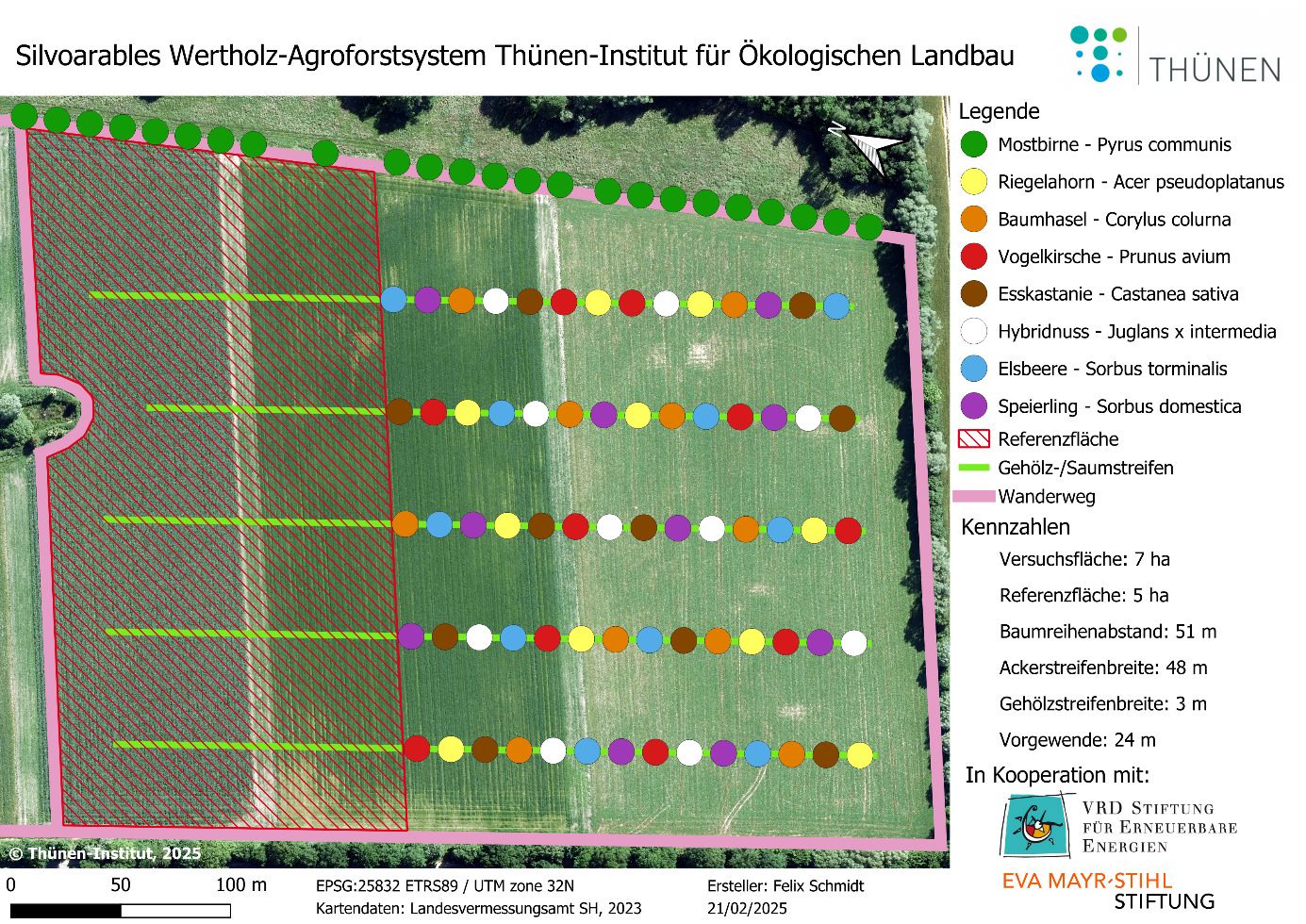Project
Establishment of a silvoarable agroforestry system for the production of high value timber
![[Translate to English:]](/media/_processed_/b/c/csm_Projekt_Agroforst_Wertholz_Image3_59cb14476e.png)
Establishment of a silvoarable agroforestry system for the production of valuable timber
This project focuses on the investigation of a newly established agroforestry system for the production of valuable timber on arable land. Agroforestry systems offer great potential to promote climate, biodiversity and water protection on agricultural land. In the new trial, we want to investigate yield formation and the aforementioned ecological synergies in the long term. In the establishment phase, we are focusing on the development of the various tree species, the control of accompanying flora and protection against wildlife and voles.
Background and Objective
Agroforestry systems integrate trees and shrubs into arable and grassland areas, creating additional sources of income, e.g. from fruit, timber or biomass production. Before the intensification of agriculture, traditional agroforestry systems - including wall hedges” hedgerows, meadow orchards and grazed woodland - characterized many cultural landscapes. In view of the challenges of climate change and the requirements for sustainable agriculture, diversification of production through agroforestry systems on arable land is considered to be highly effective.
In temperate latitudes, there has so far been little research into the establishment and yield formation of intensive timber production in agroforestry systems. However, knowledge about the ecological and economic potential of these cultivation systems is essential for their acceptance and possible expansion.
The project is being carried out in collaboration with two ongoing research projects:
- In cooperation with the project “Edelholz für eine zukunftsfähige Agroforstwirtschaft – Entwicklung, Erforschung, Pflege (06/2023–05/2026)“ of the VRD Foundation for Renewable Energies, with funding from the Eva Mayr-Stihl Foundation, practice-relevant issues are being investigated, model valuable wood systems are being established at five locations across Germany, monitoring methods and pruning guidelines are being developed and communication channels to tree nurseries are being examined. The aim is to develop scientifically solutions for farmers and policymakers and to make these accessible through targeted public relations.
- Based on the Thünen Institute of Wood Research's joint project “Verbundprojekt Wertholz (06/2021–12/2024)”, the goal is to clarify how special wood structures develop (genetically or anatomically-structurally), how they are inherited, and how trees, with a focus on sycamore, can be used efficiently from an economic perspective.
Target Group
Agricultural practice, tree nurseries, politics, consulting, science, interested professional public
Approach
The agroforestry trial was established in the winter half-year 2024/25 as a randomized block system for the trees with ten replicates on a 9 ha arable field of the Thünen Institute of Organic Farming in Trenthorst. The area is divided into five wooded strips (3 m wide) and arable strips in between (48 m wide). The wood strips contain the following experimental tree species:
- Wild cherry (Prunus avium)
- Wild service tree (Sorbus torminalis)
- Service tree (Sorbus domestica)
- Hybrid walnut (Juglans x intermedia)
- Turkish hazel (Corylus colurna)
- Sweet chestnut (Castanea sativa)
- Sycamore (Acer pseudoplatanus with special wood structure)
- Cider pear (Pyrus communis) – test trial
In addition, the following protection and maintenance measures are being investigated:
- Protection against wild animals: use of vole baskets, perches and individual tree protection
- Weed suppression: biodegradable mulch film (PLA) from vegetable cultivation, supplemented by a 3-5 cm thick layer of woodchips from hedge maintenance
- Selective pruning: regular targeted removal of branches that grow too strongly and steeply to improve the quality of the wood
A total of 490 potential timber trees were planted, which will be selected over the years to 70 marketable trees and scientifically monitored during their development. Depending on growth, tree species and target diameter, the aim is to harvest high-quality trunk wood after 45-60 years.
Detailed and further research questions on which further findings can be obtained in cooperation with research and practice partners are:
Growth and wood quality: How do the investigated tree species in solitary position develop in terms of vitality, grade, branching, rotation growth as well as height and diameter growth?
Protection and establishment strategies: To what extent does the chosen tree protection ensure a long-term effect against deer browsing, sweeping and competing vegetation?
Maintenance concepts in organic farming: How can the maintenance of woody strips be designed to be labor-efficient and biodiversity-promoting?
Legal and institutional framework conditions: How can funding instruments to support agroforestry systems be further developed in terms of environmental and climate protection?
Thünen-Contact

Involved Thünen-Partners
Duration
10.2024 - 12.2028
More Information
Project status:
ongoing

![[Translate to English:] [Translate to English:]](/media/_processed_/8/e/csm_Bildschirmfoto_2021-03-03_bearb_fc48ac88bf.jpeg)
![[Translate to English:] [Translate to English:]](/media/_processed_/8/e/csm_Bildschirmfoto_2021-03-03_bearb_ba3ec0e9d7.jpeg)






